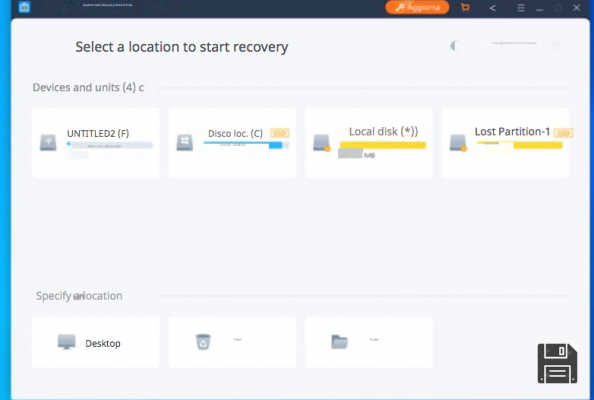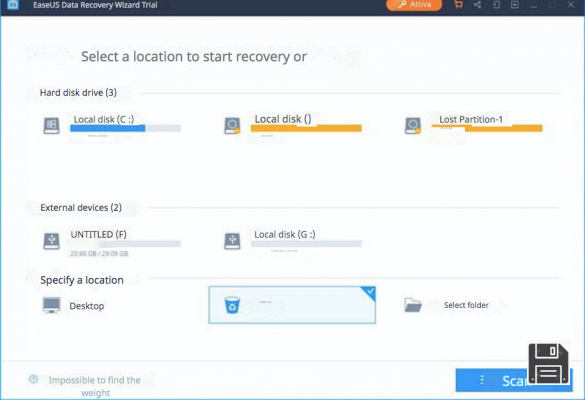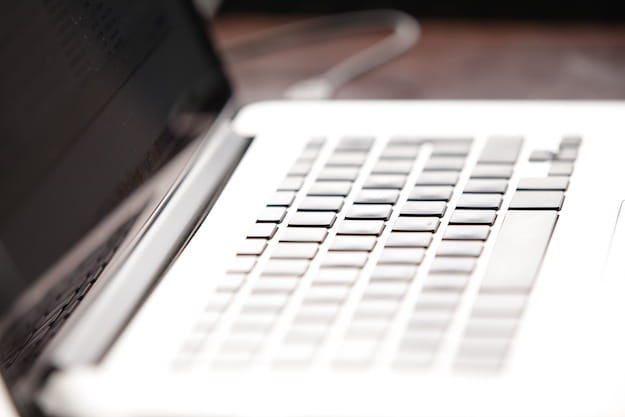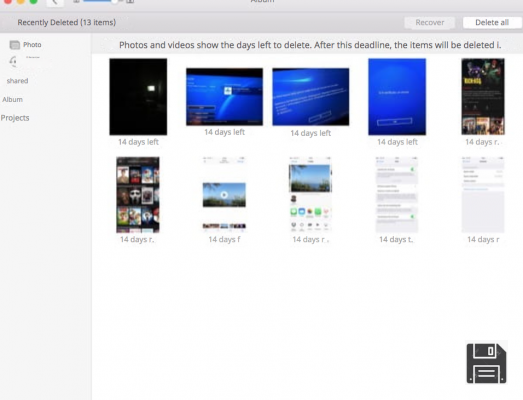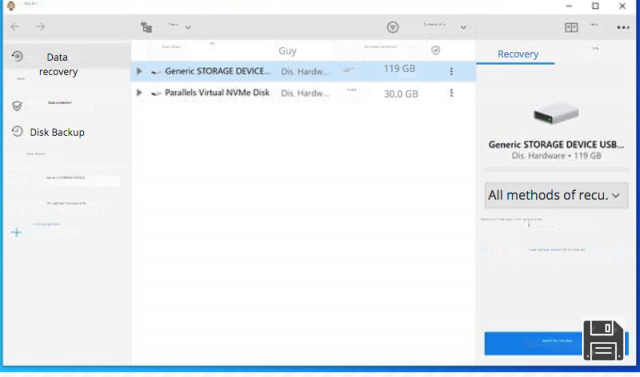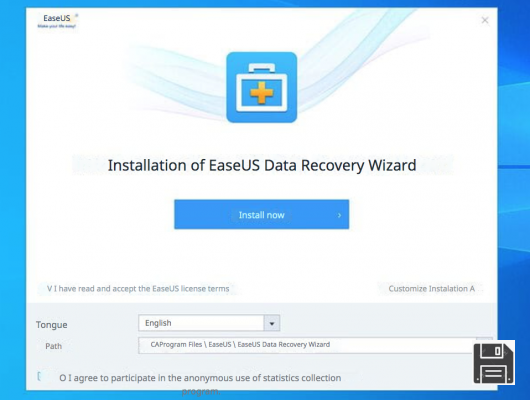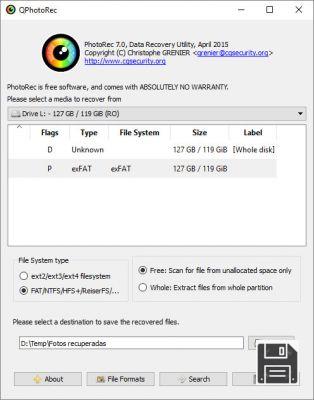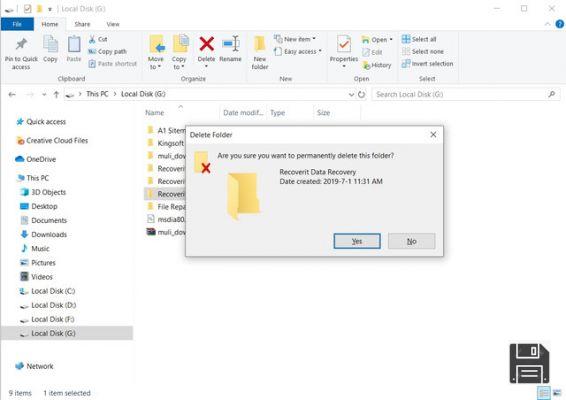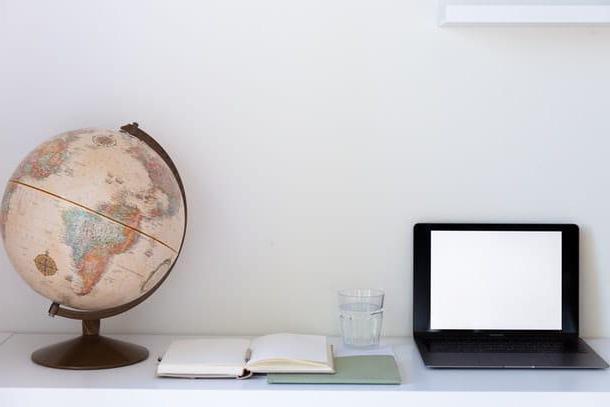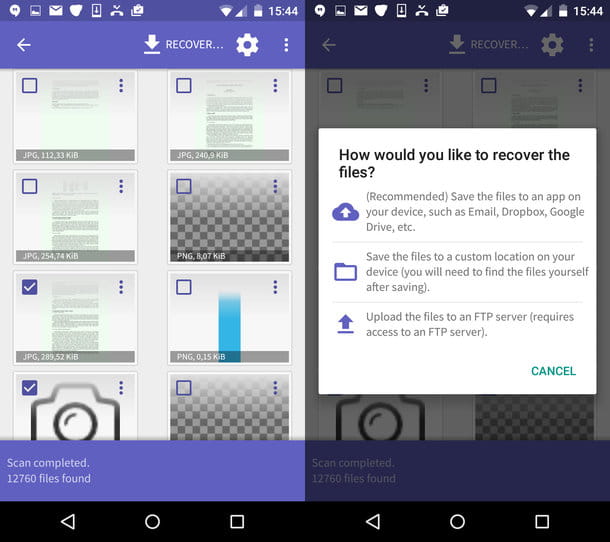You have accidentally deleted some screenshots that you took on your smartphone or PC and are now looking for a solution to recover them. Unfortunately, however, you are not very familiar with the technology and would therefore like some help in doing so. That's actually the way things are, isn't it? Then don't worry, because I can give you a lot of advice about that.
In today's guide, in fact, I'll show you how to recover deleted screenshots from both smartphones and tablets as well as computers. In detail, I will explain you how to recover these files through native operating system features where possible, or by using external software or applications to recover deleted data. In addition, I will also explain how to recover your screenshots from cloud services if you have them stored on them.
Come on, sit back and take a few minutes off to read and practice the procedures I'm going to show you in this guide. I'm sure that, at the end of the reading, you will have been able to restore the screenshots that you deleted by mistake. At this point, I just have to wish you a good reading and, above all, good luck with everything!
Preliminary information

If your intent is to recover deleted screenshots from your smartphone, tablet or computer, you must cross your fingers that they have not been deleted from the Recycle Bin, i.e. the default section of the operating system where the deleted data temporarily resides before being permanently deleted.
If files are deleted from these sections as well, it gets complicated as you need to resort to deleted data recovery software which cannot guarantee certain results. The why is soon said: when you delete a file, it actually stays on the memory of the device in use until the portion of memory that housed it is overwritten by other data.
In short, you can only recover your permanently deleted screenshots if the portion of memory that housed them has not already been overwritten by other data. In this regard, my advice is to limit the use of the device on which you want to restore the deleted screenshot, to prevent further data from being written to the portion of memory where the file to be recovered resides.
How to recover deleted screenshots on Android
To recover deleted screenshots on an Android smartphone or tablet, please follow the tips I'll give you in the next chapters. There are various resources you can use.
Google Photo/Gallery

On some Android smartphones and tablets, there is a native feature that allows you to recover images that you deleted by mistake. For example, if you use the Google Photo app, you can access the Recycle Bin section, to view and recover all the media files that have been deleted in the last 60 days: if this time limit has not elapsed since the screenshots were deleted, you can easily recover them.
To proceed, launch the Google Photo app and click on the ☰ icon at the top left. On the screen you are shown, press on the Recycle Bin to view all your deleted files. Then tap on the thumbnail of the screenshot you want to recover and press the Restore button in the lower right corner. Simple, right?
If you don't use Google Photo, you can use the Gallery app, which also allows you to retrieve recently deleted screenshots via the Recently Deleted Album tab.
Again, simply tap on the thumbnail of the screenshot to be recovered and press the Restore button at the bottom to recover it. Generally, the maximum time within which you can recover deleted screenshots is 30 days.
DiskDigger

If you were unable to recover the deleted screenshot via Google Photo Trash or Gallery app, you can turn your attention to third party apps that scan the device memory to recover the deleted files.
Among these, the one I recommend you to use is DiskDigger, which you can download completely free of charge, but a Pro version is also available at a cost of 3.37 euros, which allows you to recover files other than images.
Since your interest is to retrieve screenshots, you can take advantage of the free version of this app by reaching this link and pressing the Install button. After downloading and installing DiskDigger, tap on the Open button to start the app in question.
DiskDigger can also work without root permissions, but it will only act in the Android cache, recovering low resolution images.
On the main screen of the app, press the Grant button to grant the app root permissions if they have been unlocked on your device. After that, you have two alternatives: press the Start basic photo scan button, to scan and retrieve low resolution images (no root permissions required), or select one of the partitions below the Full Scan section (Root required), to perform a deeper scan (with root).
Now, all you have to do is choose the format of the screenshot image, which can be JPG or PNG, depending on the Android device, and grant access permissions to the operating system's features in order to start scanning.
At the end of the procedure, place a check mark on the thumbnail of the screenshot you want to retrieve and then press the Recover button at the bottom. At this point, select the method of saving the file, choosing whether to transfer it to another installed app (Save the files to an app on your device), store it in a folder (Save the files to a custome location on your device) or upload it via FTP to a server (Upload the files to an FTP server).
EaseUS MobiSaver

Another free app that can help you scan and recover deleted screenshots from the memory of your Android device is EaseUS MobiSaver. This app allows you to recover media files in JPG and MP4 format. In case you need to recover screenshots in other formats other than JPG, such as PNG, you'll have to buy the paid version, at a cost of 6.49 euros.
If you are interested in the EaseUS MobiSaver app, reach this link to view its tab on the Android Play Store. To download it to your device, press the Install button and wait for the procedure to finish. Then press the Open button to start it.
After opening EaseUS MobiSaver, give the app root permissions so that it can scan the memory thoroughly. If your Android smartphone or tablet does not have these permissions unlocked, it will scan the cache, giving you the ability to retrieve screenshots in low resolution.
On the main screen of the app, press the Photo & Video button to start memory analysis immediately. When you've found the screenshot to recover, in the Photos section, tick the box on its thumbnail and then press the Recover button at the top.
The file will then be saved to a folder on your device. Press on the eye icon in the upper right corner of the screen to access the recovered files section.
How to recover deleted screenshots on iPhone and iPad
To recover erroneously deleted screenshots from your iPhone or iPad, you can act through the default iOS "Trashcan" or using third party solutions.
Photo

The iOS media gallery is accessible via the Photo app, pre-installed in the operating system. This app allows you to manage images and videos, with the ability to recover those that you have mistakenly deleted.
To do this, start the Photo app by tapping on its home screen icon. Then, tap on the Albums tab at the bottom of the screen and scroll down to the Recently Deleted item.
Now, tap on this item to access the list of all recently deleted files. This section contains your media files for 40 days, after which they are permanently removed from your device.
If you have found the screenshot to recover, click on the Select button in the upper right corner and press on the thumbnail of the file to be restored to highlight it. After that, press on the Recover button, lower right corner, to complete the recovery operation. Easy, right?
Please note that if you've enabled the iCloud Photo Library, you'll also find your photos in iCloud via the web panel. Again, in the Recently Deleted section, you can find screenshots that you deleted by mistake.
Google Photo

If you use the Google Photo app to back up your media files on your iPhone and iPad, you can recover the deleted files by following the same procedure I described in a previous chapter of the tutorial.
Then, you have to start the app in question, press on the icon ☰, located at the top left, and select the Recycle Bin item, from the side menu. In the list of deleted files found in this section, locate the screenshot to recover and tap on its thumbnail. Then press the Restore button, located at the top, to recover the file you deleted.
EaseUS MobiSaver

Another solution that you could make use of to recover deleted screenshots on iPhone or iPad, is EaseUS MobiSaver, a desktop software for Windows and MacOS that, in its free version, allows you to recover only one file at a time. To remove this limitation, you need to purchase a license, at a cost of 69.42 euros.
Before downloading this software, it is important that iTunes is updated to the latest version. If you are operating from a Windows PC, download iTunes from Apple's website, as EaseUS MobiSaver cannot recognize the version of iTunes from the Microsoft Store in Windows 10.
Arrived at this point, download EaseUS MobiSaver on your PC from the official website of the program. On the web page that you see, click on the Download Free button and then on Download, under the heading Free. After retrieving the .exe file, double click on it and press Yes in the Windows User Account Control screen.
In the installation box, click OK, then click Next, and then check the box to accept the terms of use for the software. Now, press the Next button twice in a row and uncheck the boxes that require you to install additional software. Finally, press the Next button again, followed by the Install and Finish buttons to complete the setup.
On macOS, instead, reach this link and click on the Free Download button. This will start the download of the .dmg file for the installation of the program. After downloading it, double click on it and drag the EaseUS MobiSaver icon into the Applications folder of macOS. Then right-click on its icon and choose Open from the context menu. Then confirm the start of the program by pressing the Open button in the on-screen warning.
Once there, connect your iPhone or iPad to your computer using the supplied cable and select the Retrieve from iOS Device tab on the EaseUS MobiSaver main screen. After that, press the Scan button and wait for the analysis process to finish.
We're almost there: check the box above the thumbnail of the screenshot you want to recover (you'll find it in the Photo/Video section) and press the Recover button at the bottom. Now, choose the destination location where you want to save the screenshot and press the dial key to complete the process.
How to recover deleted screenshots on PC
If you have taken screenshots of the screenshots on your Windows PC or Mac and mistakenly deleted them, you can take action using the solutions I will propose in the next chapters.
Recycle Bin

When you delete a file on Windows computers or Macs, it is automatically moved to the Recycle Bin. In this case, you can easily recover it using the recovery feature offered by this tool.
The first thing you need to do, then, is to open the Recycle Bin screen, using its icon on your desktop (Windows) or Dock (macOS). After that, locate the screenshot you just deleted and right-click on it. In the context menu that is shown, then choose the Restore item to retrieve the image from the Recycle Bin, which will be repositioned in its original folder.
Alternatively, select the screenshot to recover and drag it out of the Recycle Bin by moving its icon to the desktop (Windows) or desktop (macOS). You can also drag it to any other folder on your PC.
Cloud storage services

If you have uploaded screenshots to cloud storage services, such as Dropbox, Google Drive, OneDrive or iCloud Drive, if you have deleted them, you can retrieve them through a special section in the respective web panels. Let's see together how to recover deleted screenshots on these cloud storage services.
If you have used Dropbox, go to its website and log in with your account credentials. On the Home screen, click File > Deleted Files in the sidebar. Put a check mark on the screenshot to be recovered and press the Restore button, in the upper left corner.
As for Google Drive or OneDrive, access the respective services through the links I provided and log in with your credentials. At this point, move to the Recycle Bin tab, located in the sidebar, and locate the screenshot to recover by clicking on it. Now, press the spinning arrow icon (Restore) at the top to restore the deleted file.
Finally, if you used iCloud Drive to store your screenshots, you can recover the one you deleted by mistake by accessing the Recently deleted section. Then log in with your credentials to the iCloud Web site and click the iCloud Drive icon, among those shown to you.
Now, click on the Recently Deleted heading in the lower right hand corner. Once you've found the screenshot you want to retrieve, simply click on its thumbnail and you're done.
PhotoRec (Windows/macOS/Linux)

If the solutions I mentioned in the previous chapters are not successful, you can rely on third-party solutions, such as PhotoRec. This free and open source software allows you to restore deleted files that are on memory drives, such as hard drives, SD or USB sticks.
If you are interested in this software, you can take it from the official website to run it on a PC running Windows, MacOS or Linux operating systems (on the latter two systems, however, it has no graphical interface but must be used as a command line). Once you have reached the web page indicated, click on Download, in the sidebar, and then click on the version of the operating system installed on your computer. I advise you not to download the beta versions, but to orientate yourself on the stable versions, on which you are more likely not to run into errors.
In case you want to recover a screenshot from your Windows PC, after downloading the .zip file, extract its contents to any folder on your computer. After that, log into it and start the qphotorec_win.exe file.
On the screen you are shown, select the memory drive you want to scan and choose FAT/NTFS/HFS+/ReiferFS in the File System Type section. Now press the File Formats button at the bottom and use the box to check the file extensions you want to recover (PNG or JPG).
Now, confirm the operation by pressing the OK button, and click the Navigate button, so that you can select the destination folder, where all recovered files will be saved. Now, all you have to do is press the Search button to scan and restore all the files with the selected extensions.
Recuva (Windows)

Recuva is a well-known free deleted file recovery software, available on Windows OS PCs. You also have the option to purchase the Professional version, at a cost of 19.95 Euros, which allows you to get automatic updates and advanced file search tools, including support for virtual partitions, but the free one should do more than fine.
To use Recuva in a simple way, you can rely on its portable version, downloadable from this link, which requires no installation. Simply extract the contents of the .zip archive on your PC and start the .exe file inside the folder.
Now, to recover the deleted screenshots, start Recuva via its .exe file. Then, on the Next button, select the Pictures option and specify where the screenshot you deleted was located (e.g. In the Recycle Bin). Then start the analysis process, using the Start button.
After the analysis is complete, you will be shown all the images identified. Place a check mark under the thumbnail of the screenshot to be recovered and press the Recover button in the lower right corner. Then choose the destination folder where you want to keep the recovered screenshot and press the OK button to complete the procedure.
For more information, you can read my tutorial on how Recuva works.
Disk Drill (Windows/macOS)

In addition to the tools I told you about in the previous chapters, you can also rely on Disk Drill, available for free on Windows and MacOS. Its free version has a limitation of only 500MB of recoverable data, which you can remove by purchasing the Pro version for $89.
If you are interested in this software, you can download it on Windows from this link and press on the Free download button. After retrieving the .msi file, double click on it and press Next (three consecutive times), Yes and finally, Close.
On macOS, on the other hand, go to this web page and press the Download Free button to retrieve the .dmg file. After downloading it, double click on it and drag the Disk Drill icon into the Applications folder. After that, right click on its icon and select the Open item in the context menu. Press the Open button again, in the on-screen alert, to confirm that the software is running.
At this point, start Disk Drill, using its quick start icon and, in the box that is shown, press the Continue button and then Start. Enter your Mac password on the screen and press the OK button to continue.
Now, locate the drive of the drive on which the screenshot you want to recover was present, before you delete it permanently, and press the Recover button. At the end of the analysis process, locate the screenshot you want to restore, put a check mark next to its name and press the Recover button to save the file on your computer.




